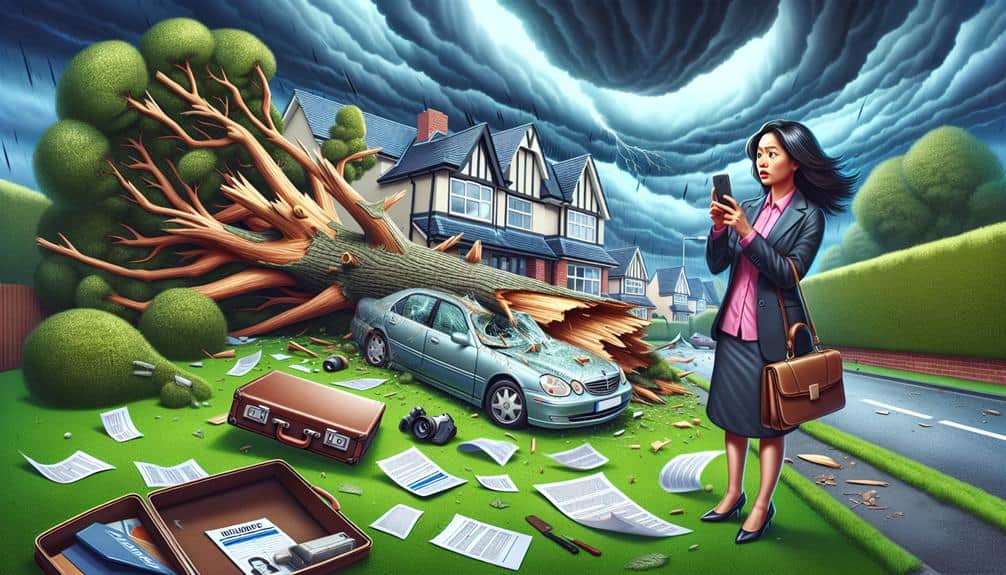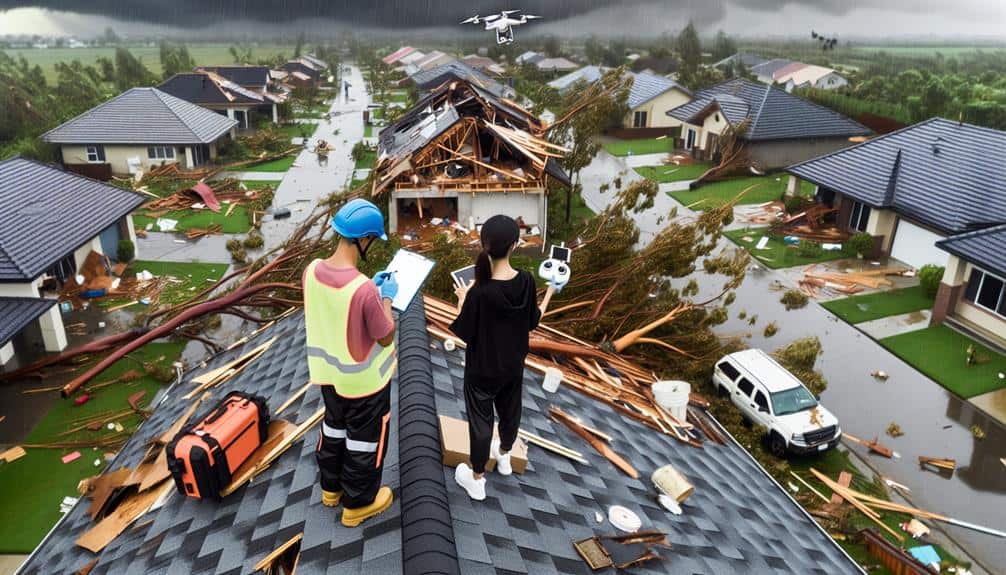Documenting tree damage post-storm is important for several reasons. We need to identify and mitigate immediate safety hazards, such as unstable trees and electrocution risks, to guarantee structural integrity. Accurate, high-resolution photos with timestamps support insurance claims, strengthening our position for fair compensation. Evaluating the environmental impact helps us implement reforestation and storm-resilience strategies. Additionally, documenting damage aids in estimating repair costs, preserving property value, and fulfilling legal responsibilities. Effective documentation also guides restoration planning, from evaluating tree stability to preventing pest infestations. For deeper insights, there's more to understand.
Key Points
- Ensures accurate safety assessments and immediate hazard mitigation.
- Strengthens insurance claims with detailed, timestamped documentation.
- Assesses environmental impact and guides reforestation efforts.
- Evaluates repair costs and property value implications.
Assessing Safety Hazards
In our initial assessment of tree damage post-storm, we must prioritize identifying immediate safety hazards such as fallen power lines and compromised structural integrity of nearby buildings. Conducting a thorough risk assessment is essential to ensuring the safety and security of the affected area. We begin by surveying the entire perimeter, methodically documenting hazards that pose an imminent threat.
First, fallen power lines require immediate attention. We must alert utility companies to de-energize lines and begin repairs. This eliminates the risk of electrocution and fire, vital for community safety.
Next, we assess the structural integrity of nearby buildings. Trees leaning against structures or branches penetrating roofs can cause significant damage, undermining the stability and safety of the buildings.
Once immediate threats are identified, we implement preventive measures. This includes removing unstable trees and limbs that could fall during subsequent storms. We also recommend reinforcing buildings that have suffered structural damage due to tree impacts.
Insurance Claims Support
After addressing immediate safety hazards, we must now focus on supporting property owners through the insurance claims process to ensure they receive appropriate compensation for storm-related tree damage. Accurate damage documentation is vital for substantiating claims. By meticulously recording the extent of tree damage through photographs, detailed notes, and professional assessments, we provide undeniable proof that strengthens the property owner's position during claim evaluation.
Our approach involves a thorough analysis of the damages incurred. We capture high-resolution images from multiple angles, ensuring that every broken branch, uprooted tree, and associated property damage is well-documented.
It's crucial to include timestamps and, if possible, geotagging to add credibility to the documentation. Additionally, a written assessment detailing the type, age, and health of the trees pre-damage can further validate the claim.
Environmental Impact
Storm-induced tree damage greatly alters local ecosystems, disrupting wildlife habitats and affecting biodiversity. When trees are uprooted or severely damaged, they no longer provide essential cover and food sources for various species. Birds, insects, and mammals that rely on these trees for nesting and foraging are forced to relocate, potentially leading to a decline in local biodiversity. Documenting this damage allows us to assess the extent of disruption and implement strategies for ecosystem preservation.
Moreover, fallen trees contribute to an increase in greenhouse gases. Decaying wood releases carbon dioxide back into the atmosphere, exacerbating climate change impact. By meticulously documenting the damage, we can prioritize which areas need reforestation or other mitigation efforts to offset carbon emissions. This is vital for maintaining the delicate balance within our ecosystems and combating climate change.
Additionally, understanding the patterns and severity of tree damage helps in developing resilient urban planning and forestry management practices. These practices can mitigate future storm impacts, furthering our commitment to ecosystem preservation.
Let's not underestimate the power of documentation; it's a pivotal step in ensuring sustainable and resilient ecosystems for future generations.
Property Value Considerations
When considering property value, we must evaluate the repair costs associated with tree damage.
We also need to navigate the complexities of the insurance claim process.
Understanding the implications for future property sales is crucial.
It's essential to quantify the financial impact accurately, as unaddressed damage can depreciate property value substantially.
Assessing Repair Costs
In evaluating the repair costs of tree damage, we must meticulously consider the impact on property value, factoring in variables such as tree species, age, and the extent of the damage. Accurate cost estimation hinges on a thorough assessment of these elements.
For high-value species like oak or maple, repair costs might be substantial, but their contribution to property value justifies the expense. Conversely, less valuable species may not warrant extensive repairs.
It's essential to establish a clear repair timeline. Immediate actions, such as removing hazardous limbs, prevent further damage and mitigate safety risks. However, some repairs, like soil decompaction or tree bracing, require expert intervention over a protracted period to ensure tree health and stability. In this way, our timeline must balance urgency with long-term sustainability.
We also need to account for the tree's age. Mature trees often have higher replacement costs due to their established root systems and significant canopy. Younger trees, while easier to replace, may still incur costs if they contribute to the landscape's aesthetic value.
Insurance Claim Process
Managing the insurance claim process for tree damage requires a deep understanding of policy specifics and the ability to accurately document the impact on property value. When filing a claim, we need to ensure our damage assessment is thorough and precise. This not only helps in determining coverage eligibility but also influences the amount of compensation we might receive.
To effectively manage this process, we should:
- Review Policy Terms: Understand what our insurance policy covers, including exclusions and limitations related to tree damage.
- Document Damage: Take detailed photographs and notes detailing the extent of the damage, focusing on how it affects the property's value.
- Obtain Professional Assessments: Hire arborists or property appraisers to provide expert evaluations that can support our claim.
- Maintain Records: Keep all receipts, repair estimates, and any correspondence with our insurance provider organized for easy reference.
Future Sale Impact
Evaluating the future sale impact of tree damage on property value necessitates a detailed analysis of how the damage alters the landscape, curb appeal, and overall marketability of the property. When trees are damaged, it can impact the aesthetic and functional aspects of the outdoor space. A well-maintained landscape plays a vital role in attracting potential buyers and enhancing property value.
First, let's consider how tree damage impacts curb appeal. Trees often serve as focal points in landscaping, and their absence or visible damage can make a property less inviting. This reduction in visual appeal can lead to lower initial interest from buyers. Moreover, prospective buyers might view the need for home renovation and property maintenance to rectify tree damage as an additional burden.
Additionally, trees contribute to the ecological value of a property by providing shade, reducing energy costs, and improving air quality. Their loss can diminish these benefits, potentially lowering the property's overall marketability.
Hence, documenting tree damage thoroughly can aid in negotiating fair market adjustments or facilitating necessary home renovation efforts to restore the property's appeal. By taking these steps, we guarantee the property remains competitive in the real estate market.
Legal Implications

In addressing the legal implications of tree damage post-storm, we must consider the critical role of thorough documentation for insurance claims, serving as irrefutable evidence to substantiate our losses.
Additionally, understanding the nuances of liability and responsibility is paramount, particularly when determining fault or negligence in cases where damaged trees affect neighboring properties.
Insurance Claims Evidence
When recording tree damage for insurance claims, we must carefully capture photographic evidence and detailed notes to substantiate the extent of the destruction and ensure our claims hold up under legal scrutiny. Visual evidence is crucial; high-resolution photos and videos from multiple angles provide a thorough view of the damage.
This visual documentation must be paired with detailed notes, specifying the date, time, and precise location of the damage to strengthen the claim's credibility.
Documentation importance can't be emphasized enough. Accurate records help us establish a clear narrative of the events leading to the damage, which is essential for insurance adjusters and legal proceedings. To guarantee thorough documentation, consider the following:
- Take timestamped photographs: Make sure photos are time-stamped to verify the date and time the damage was recorded.
- Capture before-and-after shots: These offer a comparative baseline, illustrating the extent of the damage versus pre-storm conditions.
- Include detailed descriptions: Write detailed notes that describe the damage, including measurements and potential hazards.
- Document surrounding environment: Display the broader context, such as nearby structures or other affected trees.
Liability and Responsibility
Determining liability and responsibility for tree damage post-storm involves understanding legal implications that may affect both property owners and insurance providers. It's essential that we grasp the nuances of risk management and property ownership to navigate these complexities.
When a storm causes a tree to fall, the location of the tree and the damage it inflicts play significant roles in liability. If a tree from our property falls onto a neighbor's property, we're potentially liable for the damages, especially if prior negligence can be proven.
Effective risk management means proactively maintaining our trees to minimize hazards. Inspections and timely pruning can mitigate risks, reducing our liability. If a storm damages a well-maintained tree, many insurance policies may cover the resultant damage, but clear documentation is essential. We should photograph and catalogue the damage, noting any pre-existing conditions that could affect a claim.
The legal implications of tree damage can extend to municipal regulations as well. Some jurisdictions have ordinances about tree maintenance and removal, adding another layer of responsibility. Understanding these regulations is pivotal for property owners who value their freedom and seek to avoid legal complications.
In short, thorough documentation and proactive risk management are our best defenses in these scenarios.
Restoration Planning
Restoration planning demands a thorough analysis of the extent of damage, prioritizing immediate interventions to stabilize affected trees and prevent further deterioration. By documenting the damage, we can devise effective restoration strategies that not only focus on tree preservation but also consider the broader community impact.
Our disaster response begins with a detailed assessment, enabling us to allocate resources efficiently and address the most critical areas first.
To ensure an all-encompassing restoration plan, we must:
- Evaluate structural integrity: Assess each tree's stability to determine if it can be saved or if removal is necessary.
- Conduct soil analysis: Examine soil conditions post-storm to understand changes in nutrient availability and compaction.
- Implement pruning techniques: Use precise pruning to remove hazardous limbs, encouraging healthy regrowth.
- Monitor pest infestations: Identify and mitigate pest issues that could exploit weakened trees.
These steps not only facilitate immediate disaster response but also contribute to long-term tree preservation. By meticulously documenting storm damage, we empower ourselves with the data necessary to implement restorative measures that enhance our community's resilience and ecological health.
Frequently Asked Questions
How Can I Safely Document Tree Damage Without Professional Help?
We can safely document tree damage using DIY methods by following safety precautions like wearing protective gear. Utilize remote assistance and online tutorials for detailed guidance, ensuring we maintain freedom while conducting thorough, accurate damage assessments.
What Tools Are Best for Photographing Tree Damage?
Balancing convenience and precision, we recommend a camera for high-resolution images, drone photography for aerial views, and smartphone apps with GPS mapping for geotagging and organizing data. These tools give us both autonomy and accuracy.
Can Documenting Tree Damage Help in Future Storm Preparedness?
Documenting tree damage aids in future storm preparedness by enabling data analysis and risk assessment. We can identify patterns, predict vulnerabilities, and implement mitigation strategies, ultimately enhancing our resilience and safeguarding our freedom from catastrophic impacts.
How Should I Organize Tree Damage Documentation for Easy Reference?
To organize tree damage documentation for easy reference, we should use digital organization and labeling for photos and notes. Additionally, maintain a physical notebook with detailed sketches. This hybrid approach guarantees thorough and accessible records.
What Are the Common Mistakes to Avoid When Documenting Tree Damage?
Why do we often overlook proper angles and detailed descriptions when documenting tree damage? We must avoid common mistakes like poor lighting, lack of scale indicators, and inadequate notes. Let's make sure our documentation is precise and thorough.


